
Lives Discovered in a Vermont Cemetery
I obsess over each Food for Thought I write. I take at least two weeks to muse over every word, nuance, and grammatical and spelling error on the horizon. Not this time. I am writing off the cuff of Vermont, in time for All Hallows Eve, Halloween and Dia de las Muertos.
The heart of this story is the ancient Newfane Hill
Cemetery in South Newfane, Vermont. It is where my granddaughter discovered the
most unusual gravestone I have seen in my fifty-one years of cemetery
excursions.
Knowing my history and love of Vermont, my son was my
chauffeur. He drove Tim and I and his children down old logging trails, dirt
roads, through magnificent fall foliage, nearby lakes, rivers, and small
villages. On one back road I noticed a cemetery and screamed, “STOP! Can we
visit this cemetery? It looks really old.” Of course, my dear son complied.
We all set forth through the old gate and entered this
ancient, sacred place. Rarely had I seen so many pristine gravestones, many in
slate. It was as though this site had been protected by the old maples and oaks
overhead, their gathering branches preserving this hallowed world below.
We began to investigate, wandering between gravestones
in search of the oldest ones. As we walked I shared with my granddaughter my
history of gravestone rubbings and instructions on the art of gravestone
rubbing. We marveled over the beauty of each discovered stone. I emphasized the
intricacy of each stone. They were works of art from weeping willows to angels
to sorrow-filled faces to the admonishments of the dead to the living, all
etched into stone by artisans. We talked of the wonder of each life lived,
memorialized on slate or marble. We mused over life’s instructions one
gravestone provided, “As you are now so once was I, prepare for death and
follow me.” Sobering thoughts for a ten-year old girl or a seventy-two year old
woman.
We discovered one of the oldest gravestones, which
captivated us. Hezekiah Taylor died in 1817, and had been educated at “Harvard
University, Cambridge, MS.” Imagine that, the grave of a man who had attended
the same school, Harvard, where my granddaughter's great-
Grandfather had been a professor and her
great-grandmother had infused the love of art, the necessity of art
scholarships, endowments and galleries into those vaulted halls of Harvard.
The gravestone we read proclaimed Hezekiah to be an
esteemed, well-respected man who had become a pastor of his “own congregation.”
Next to his grave was that of Sarah, the “Consort” of Hezekiah.
I was astounded. Consort? Wasn’t that a polite way of
saying “mistress?” Although there were no birth dates on either stone, I calculated
that they were born the same year, 1751. Sarah had outlived Hezekiah by 23
years. Her last name was not included on her stone, leaving her identity a
mystery and open to speculation. Perhaps they were childhood friends, who later
became secret lovers? Did they ever marry? Sarah’s story entices me, draws me
into her hidden life. I returned to the present with my granddaughter's
question, “What’s a consort?”
Webster's Dictionary defines consort as a partner or
spouse. I assumed Sarah was not a spouse as her last name was absent from her
stone, not entirely unusual. I wondered how much I should reveal to my
granddaughter in this age of political correctness. A girlfriend, or the
mistress of a well-respected Reverend?’ To be safe, I replied, “A girlfriend or
a partner.”
We read the passage on the gravestone together:
“SARAH, consort of Rev. Hezekiah Taylor, died March 28, 1840, AE 89 years. This
marble was erected by a few female friends as a memorial of her worth and their
affection.”
We had discovered the first gravestone erected for a
female “consort'' in any cemetery I have ever encountered in my 54 years of
gravestone-rubbing history. This was early-world feminism and love. A group of
women, “with affection,” wanted to validate Sarah’s life, the consort of their
reverend. At her age of death, 89, there would have been few of her peers left
to erect a stone for Sarah or those with the funds to do so. Her “few female
friends” did, “with affection.”
We backed up to view the stones to a greater advantage
and stumbled over another esteemed gentleman’s gravestone, a well-respected
attorney, and “Esquire.” Lo and behold, next to his grave was another “consort.”
Her gravestone had also been placed by the same group of women as Sarah’s, but
with a different epitaph. We searched, but could not find more than those two consorts
in the entire cemetery.
We had stumbled onto consorts of history. In this
1750s cemetery, Sarah, Consort of Hezekiah, had been given her value, her
worth, by her “few female friends'' who remembered her “with affection.” She
had become memorialized in stone. Her female friends were determined not to
allow Sarah’s life to be unremembered and unremarked. Sarah would not lose her
foothold in their lives and hearts as the years turned over in their graves.
Each life lived is a personal adventure known
intimately to those closest to the departed. Only their date of birth, death,
occupation is usually etched into their gravestone, along with a favorite verse
or admonishment to the living. In family plots, one can identify the children
of the departed. The rest of their lives is a mystery, waiting to be revealed.
Sarah, consort of Hezekiah, beckons me from her gravestone. Hers is a life I
long to discover, to delve into. She is a temptress awakening my imagination,
asking me to follow her down the path of her long-forgotten existence.
Each grave visited tempts me with the same love of
history and discovery. These cemeteries, cities of stone, remind us of the
importance of each life lived, of each personal adventure, triumph or failure.
It is up to the living to delve into and provide value to our past. My love of
cemeteries and initiating my granddaughter into the beauty, peace and necessity
of respecting and preserving our past led to this unexpected discovery in a
hidden cemetery, nestled in the Green Mountains of Vermont.
History matters. I am forever immersed in the grace of
gravestones and the past. I strive to pass this torch to the next generation of
Sarahs.
Until the next page is turned I’ll enjoy researching and will keep you posted on any historical discoveries I encounter. Happy hunting and haunting!
*** To learn more about the history of Newfane, go to: https://tinyurl.com/yc93thkn and http://brattleborohistory.com/taverns-roads/henry-wheelock-tavern-1822.html***
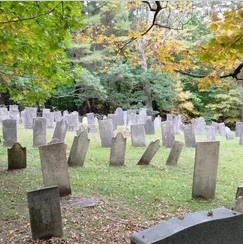
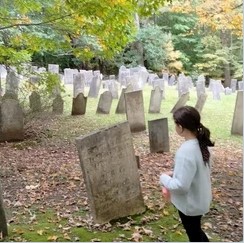
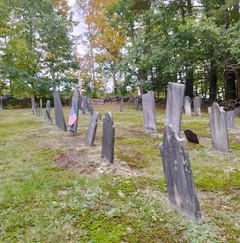
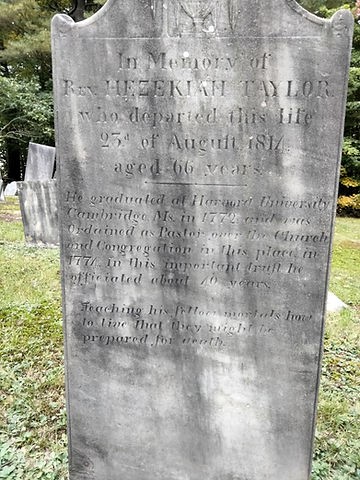
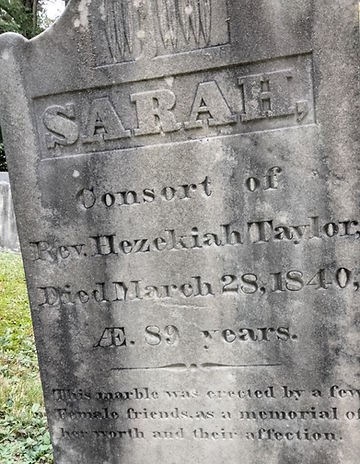
Post Views : 575